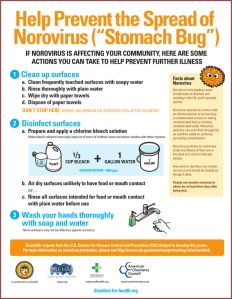The other day I found myself in the break room near my lab eyeing a container of chocolate-covered nuts left over from the Christmas holiday. Someone left them out as a treat for foraging graduate students and post-docs. I stood for a moment holding a single piece in my fingers and as I was about to put it into my mouth, I remembered—Norovirus!
I had no reason to think the nuts could be a reservoir of norovirus, but I did have good reason to avoid shared uncooked food with an unknown history. A good chunk of my family had just had their holiday ruined by the virus, sometimes known as the 24-hour bug or stomach flu. It causes gastroenteritis, or inflammation of the gut, complete with diarrhea, vomiting and overall exhaustion. It can only be transmitted via stool or vomit, and though there was certainly none of that visible in the bin of delicious looking nuts, I began to think of all the hands that may have been inside. If it came from a family holiday party, some of those hands may have belonged to kids who haven’t yet learned to wash them for a full 30 seconds after using the bathroom. I threw the candy away, closed the container and left the break room.
I may have avoided norovirus that day by a judicious food choice, but not everyone has that moment of doubt before sharing a drink, holding a child’s hand or ordering a deli sandwich. It is sometimes just unavoidable, especially because it’s contagious for up to two weeks after the first horrible 24 hours. The center for disease control estimates that 19-21 million people are infected with norovirus each year and it’s actually responsible for somewhere between 600 and 800 deaths per year. Those most vulnerable are either over 65 or under 5 years old.
These figures are driving researchers to search for a vaccine, even if just for those most vulnerable or during outbreaks. But norovirus, or I should say noroviruses are particularly complicated. They are split into 5 groups (I-V) based on how similar their DNA sequences are. Those groups, called genogroups, are split into anywhere between 8 and 30 genotypes and those can be further divided into variants. The classification is complicated enough to require the use of a software program that compares genome sequences.
Only three of the genotypes can infect humans and the strain GII.4 has been the most common cause of outbreaks since the early 2000s. For decades before that, a different strain dominated, and the power structure may shift again. The abundance of genotypes and variants and their changing frequencies in communities make vaccine design a daunting task. On top of that, researchers are still discovering new genotypes and variants. In 2012 a strain called GII.4-Sydney was identified in Australia and made its way to the UK and the US within a year.
There is evidence that infection with norovirus can generate immunity in some people, meaning that once they get infected, they are protected from re-infection for some weeks or months. However, no one knows how all of the viral subgroups and variants might affect immunity and vaccine design. In a study published in September, researchers from the University of Florida infected mice with one of two closely related norovirus strains and found major differences in the immune responses.One of the two strains was much better at activating a class of immune cells called antigen presenting cells. These include dendritic cells and macrophages, and they are experts at displaying pieces of virus and training B and T cells to respond to the infection and turn into memory cells. As a result of the enhanced response, infected mice were protected from a reinfection six weeks later.
{Researchers determine “protection” by measuring how much virus shows up in an animal’s organs after infection. In this case, they measured norovirus in the small and large intestines and in the lymph nodes attached to the intestines.}
Oddly enough, the researchers narrowed down the cause of these changes down to a group of structural proteins whose sequences only varied by about 10% between the two strains.
A key finding in this study was that the protective norovirus strain protected mice from re-infection with both strains. This is important since any vaccine against norovirus would have to protect against several strains and genotypes. It also points out specific characteristics of the immune response that make all the difference between becoming immune or getting re-infected, for example, robust antigen presentation and B and T cell memory. A vaccine that could foster those characteristics could potentially protect people from several norovirus strains. It may take a while to get there. In the meantime I will keep my hands clean and out of community candy dishes.
*A reader noted that the poster above says norovirus is contagious for 2-3 days, whereas I wrote above that it can be contagious for 2 weeks. To clarify, the virus is most contagious for 2-3 days, but it can continue to be shed in stool for 2 weeks. See http://www.cdc.gov/norovirus/preventing-infection.html for more.
Sources:
Zhu S., Regev D., Watanabe M., Hickman D., Moussatche N., Jesus D.M., Kahan S.M., Napthine S., Brierley I. & Hunter R.N. & (2013). Identification of Immune and Viral Correlates of Norovirus Protective Immunity through Comparative Study of Intra-Cluster Norovirus Strains, PLoS Pathogens, 9 (9) e1003592. DOI: 10.1371/journal.ppat.1003592.s001
Hoa Tran T.N., Trainor E., Nakagomi T., Cunliffe N.A. & Nakagomi O. (2013). Molecular epidemiology of noroviruses associated with acute sporadic gastroenteritis in children: Global distribution of genogroups, genotypes and GII.4 variants, Journal of Clinical Virology, 56 (3) 269-277. DOI: 10.1016/j.jcv.2012.11.011


